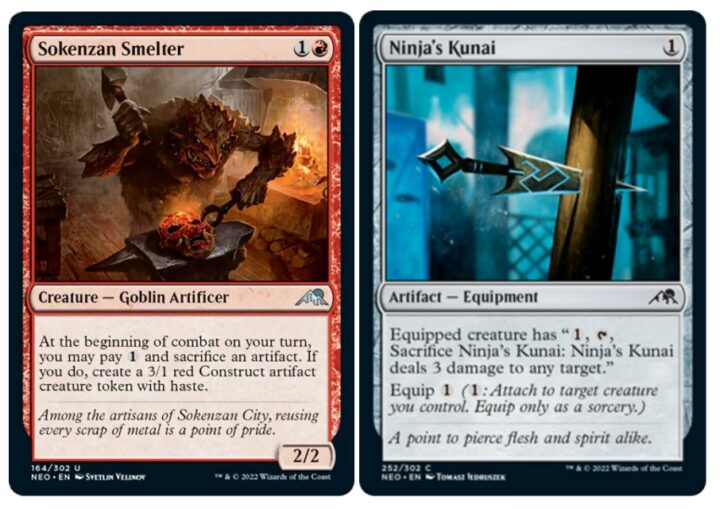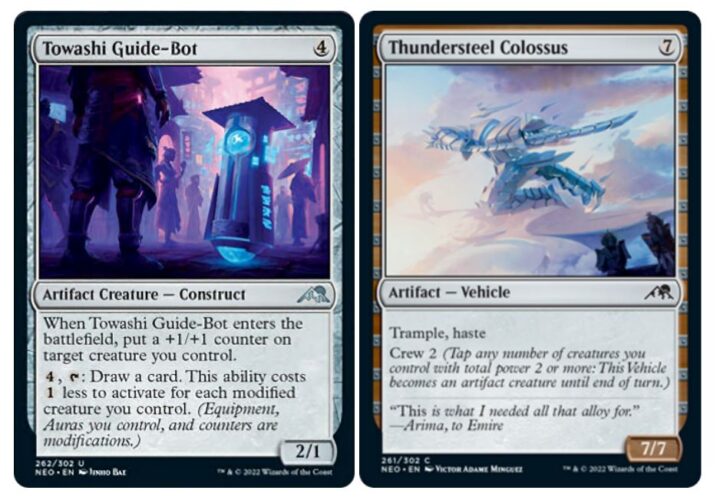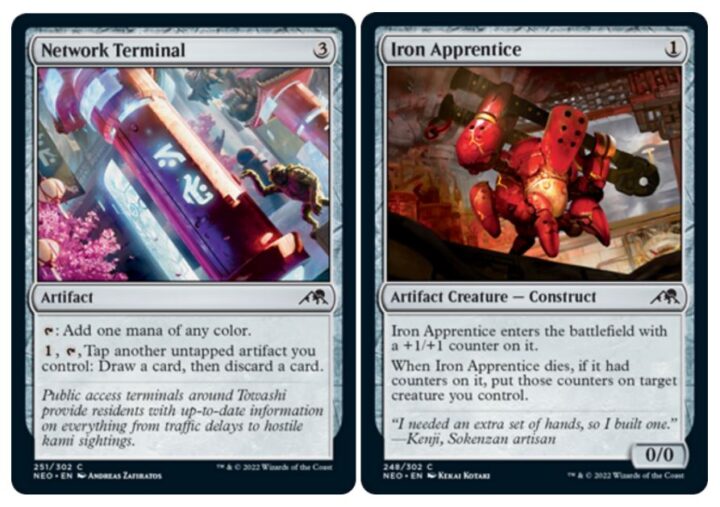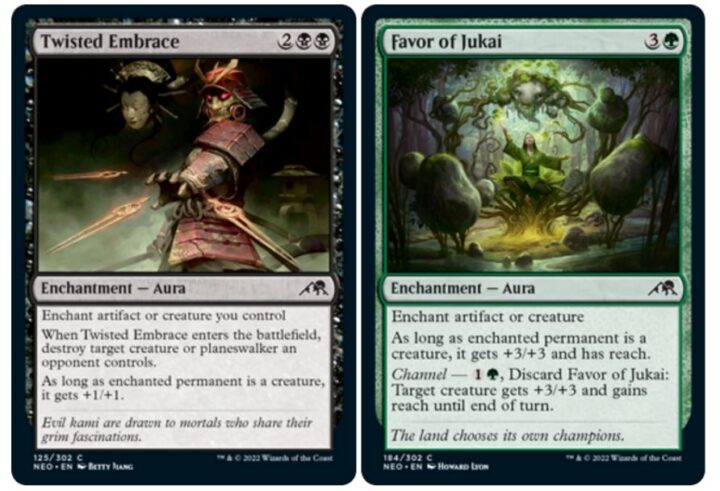Welcome back, my scientifically-minded Draft players! At time of writing, almost two weeks of Kamigawa: Neon Dynasty Limited are on the record. Various surveillance thopters and cyber kami have begun filtering that data into a more complete picture of the format – one that can supplement and validate our first instincts as Magic players. That’s what this Draft By Numbers guide attempts to do, and I hope that both the conclusions and methodology will help you all reach a more confident understanding of this awesome new set!
Speaking of methodology: the match data I use is from 17lands.com, which collates the stats from a community of MTGA players who have installed the 17lands tracker. All the numbers I quote here will be from MTGA Premier Draft (Ranked Best-Of-One) events, since those are the most popular and give us a significant sample size of games to look at. For similar reasons, I tend to ignore rare and mythic rare cards in my analysis, since you can’t really rely on any specific rare in your high-level drafting strategy.
THE DIFFERENCE ENGINES
17lands lets you break down the raw stats on each card in Neon Dynasty by which colors of deck it’s played in, how early it was drawn, and other useful filters. But when we need to sum up a card’s overall value in Draft, I like to use IWD (Impact When Drawn).
This stat looks at games won and lost by decks which included that specific card, and shows how much more they won when that card was drawn, compared to when it wasn’t. Since this comparison eliminates most of the statistical noise from other good cards that might be in a deck, it’s the best starting point when thinking about your pick order. For example, here are each color’s best all-around commons – the ones you can confidently pick up in Pack 1 for any deck of that color – based on IWD:
White: Spirited Companion (+8.3%), Imperial Oath (+8.2%)
Blue: Network Disruptor (+9.1%), Moon-Circuit Hacker (+5.7%)
Black: Okiba Reckoner Raid (+7.2%), Virus Beetle (+6.4%)
Red: Kami’s Flare (+3.4%), Voltage Surge (+2.2%)
Green: … uh, all of them?!
Almost every single green common in Neon Dynasty has a positive IWD across all decks, which is highly unusual for Draft. For comparison, fewer than 1/3rd of red commons score positive overall IWD. Does this mean that red is a drastically worse color in this format? Let me get back to you on that later.
IN NEON COLOR
17lands also lets us zoom out from the card data and just look at the popularity and success of decks by color combination. The biggest piece of advice I could offer in last week’s Draft Guide was not to get too pigeonholed into the themes suggested by NEO’s cycle of gold “signpost uncommons.” This is very much a synergy-focused set, but the playable synergies don’t align as neatly with these gold uncommons as they often have in past sets – and therefore, not every color combination is truly supported.
The percentages labeled at the bottom show the relative share of all two-color decks in the sample size. Not only are some of these color archetypes significantly more successful than others, but the four most successful decks are more commonly played than all the rest combined! The WB, BG and UG decks are the “hidden” overperformers relative to their popularity; these color combinations focus on generic value over a specific mechanical theme like RW Samurai or UW Vehicles. Their flexible nature also lets you assemble them more freely, building toward whichever synergies become available in your packs.
In fact, I recommend looking to individually strong cards first in Neon Dynasty Draft, regardless of your colors. Splashing is very realistic both in and out of green, and the synergy decks which succeed – chiefly, Ninjas and Enchantments – do so because they “synergize” with basically any card and benefit any style of play. You’re rarely caught trying to use two bad cards to make each other good, and that’s what matters most here.
RED DECK REDEMPTION?
Red decks, on the other hand, seem like they have to play a lot of bad cards by default. Remember, the vast majority of red commons actually had a negative IWD across all games where they were played! But this is where we need to ask smarter questions to get smarter answers. RB, UR and even mono-red decks have been putting up numbers with a combination of artifact synergies and strong interaction.
But where green and black cards are strong in a generic, always-great way, red’s best cards change completely even between these three artifact decks. Averaging them all out is how we get the statistical mediocrity I mentioned before. So, let’s instead look into their IWD on a per-archetype basis to find out which artifacts go in which red decks, and why.
These are probably the only red and colorless artifacts worth picking – except the gold uncommons, which you should still definitely take when in-color.
Mono-Red: Aggressively slanted with a curve ending around three, these decks want artifact creatures first, removal for blockers second, and everything else never. Very few cards stand head and shoulders above the pack, so what matters is having as many copies of these effects as possible. Vehicles are significantly worse than actual creatures. Sokenzan Smelter is the only “artifact engine” this deck cares about.

Black-Red: The slowest archetype of the three by a lot. Doesn’t need the most powerful creatures; mostly wants chaff for its sacrifice outlets and late game threats like Thundersteel Colossus. Red’s cheap removal joins Twisted Embrace to clear threats, with Shrine Steward to tutor the latter. Card advantage ideally comes from self-contained creature sources like Dockside Chef, Towashi Guide-Bot and Virus Beetle – not costly engine pieces that need help getting going. Okiba Reckoner Raid is a better direct damage spell than Dragonspark Reactor.

Blue-Red: Mostly a tempo deck which clogs up the ground and chips away in the air while holding up interaction. Has potential to build around value engines like Containment Construct and play control, but the best thing is to just pump and equip the flyers. Oni-Cult Anvil does even better here than in RB, perhaps because UR makes more artifact tokens. Almost every blue common is positive IWD in this deck, and the Ninjas will often be better than random artifacts – just add engines, removal and tricks to that.

Hopefully the chart above sheds some light on why the red cards are looking weaker than they play. I considered delving into the stats on RW and RG decks, but they tend to not care about the artifacts at all, and are also the hands down worst color combinations in the format. Sadly, I recommend that you just never draft them, if you can help it.
PLAYING THE STATS AGAINST EACH OTHER
As our last detailed inquiry into the nature of Neon Dynasty Draft, I want to introduce another very important stat you can track through 17lands (or other data-tracking sites of your choice). So far, the Draft By Numbers series has focused on using IWD, since that’s the best stat for drawing high-level conclusions about which cards are doing well. But there are still situations where IWD can be misleading, and where bringing in a second stat for comparison can perhaps help us make a huge discovery.
One problem with IWD relates to “build-arounds” or other niche cards. Because IWD only tracks how much a card improves your win probability when drawn, it can’t account for the “deck building costs” attached to playing it. Of course the card you build your deck around makes your win rate shoot up when you draw it! But that’s only relative to your win rate when you don’t – and what does that look like? What price are you really paying to pad the IWD of that build-around?
While I’d love to take this even further and try to measure the impact right from when we pick the card, 17lands can’t filter down “times picked” based on deck color, so that’s not really useful. Instead, we can look at the “Games Played Win Rate” column, which simply tells us the win rate of decks playing the card – no attempt to account for the card’s role in that win rate. We can then use this as a quick sanity check to catch weird outliers with misleading IWD!
For instance, Walking Skyscraper is theoretically one of the better threats for UR decks in this format. It has the third-highest IWD of colorless uncommons at a respectable +2.8%, normally enough to snap it up on sight. However, its GPWR of 49.5% is 3-6% lower than any other uncommon on the list, even the negative-IWD Towashi Guide-Bot!
So yes, Walking Skyscraper has been a great card, but only for the very worst UR decks. Either people are overcommitting to the Walking Skyscraper plan, or the cost of building around it is too high to justify, or perhaps the most successful drafters just aren’t running it. Whichever is the case, we should probably not take its IWD at face value.
OVERS AND UNDERS
But it’s not just weak GPWR which can hint at an overrated card! Simian Sling is the most played (GP) common in mono-red decks, and at 58.8% GPWR, decks playing Sling are also among the most successful, second only to Unstoppable Ogre’s 58.9%. You’d expect the most played and most successful card to have a high IWD, but it’s actually one of the worst in mono-red, at -3.5%!
We could brush it off as just a symptom of mono-red’s smaller sample size. But like other reconfigure creatures, Simian Sling has significantly better stats in WR and UR than it does in any other colors. And since mono-red plays a different style of aggro than those decks, it looks like the community might be overrating Sling for mono-red specifically, while its GPWR coasts on the achievements of better cards.
What about cards that are currently underrated or under-picked? Can we look for the opposite discrepancies between GP, GPWR and IWD and find some gems hiding in the community’s blind spot? Well, let me tell you about a particular green common: Harmonious Emergence.
Statistically, it’s in the top echelon of green cards – a great pick you can take early because it is so consistent across different green decks. In GB (which, again, is the strongest-performing archetype in Neon Dynasty Draft), Harmonious Emergence is actually the #1 most-impactful green common of the set.
So, how many people are actually playing Harmonious Emergence? Not nearly enough. The two tall sets of bars on that chart are roughly measuring “how good is the card in this deck” and “how good are the decks this card is in.” The third bar shows how far down the gap is to “how good people think it is,” and it’s not even to scale in terms of how big the gap between one common and the next might be. Did I mention you can tutor for Emergence with Shrine Steward, which is also a great all-around card flying under the community’s radar?

Even more egregious is a card which I myself totally glossed over: Lucky Offering. Again, these stats are all for Best-Of-One Draft, so a spell that only kills cheap artifacts seems way too narrow to be playable in the main deck. The community agrees: Lucky Offering is the absolute least-played white common in every single white archetype. But on IWD? Second-best common in WR (+2.9%), 3rd in WG (+4%), 3rd in WB (4.7%), and 9th in UW (+3.4%).
One of the better cards in the whole set has been consistently left till last in packs (and left out of our decks), because it’s hard to wrap your head around how useful it is in this artifact-rich, aggro-heavy, removal-light environment. Lucky we have a neutral stat aggregator to point it out!
Other common/uncommon cases of GP vs. IWD discrepancy:
- Born to Drive (underplayed everywhere except RW)
- Explosive Entry (underplayed in everything)
- Undercity Scrounger (overplayed, especially in RB and WB)
- Acquisition Octopus (overplayed, especially in UB)
- Planar Incision (underplayed in everything)
- Short Circuit (heavily underplayed in UW and UG)
- Shrine Steward (underplayed in everything – it gets your best removal!)


PLANNING MY OBSOLESCENCE
Well, that’s all the stat-computing cycles this sage has time for right now. I hope that this guide helps inform your drafting, or at least inspires you to take a better look at the stats to prove me wrong!
It’s been a pleasure to see how much recent Limited content has turned toward “learning to learn,” or at least demystifying the instincts of successful drafters, so that more and more players are equipped to figure out strategies on their own. If I can spread my knowledge well enough to one day make Draft By Numbers obsolete, that would be my proudest achievement.
…You’ll all still come through and click on the articles out of respect, though, right? Awesome. See you next set!

Tom’s fate was sealed in 7th grade when his friend lent him a pile of commons to play Magic. He quickly picked up Boros and Orzhov decks in Ravnica block and has remained a staunch white magician ever since. A fan of all Constructed formats, he enjoys studying the history of the tournament meta. He specializes in midrange decks, especially Death & Taxes and Martyr Proc. One day, he swears he will win an MCQ with Evershrike. Ask him how at @AWanderingBard, or watch him stream Magic at twitch.tv/TheWanderingBard.

